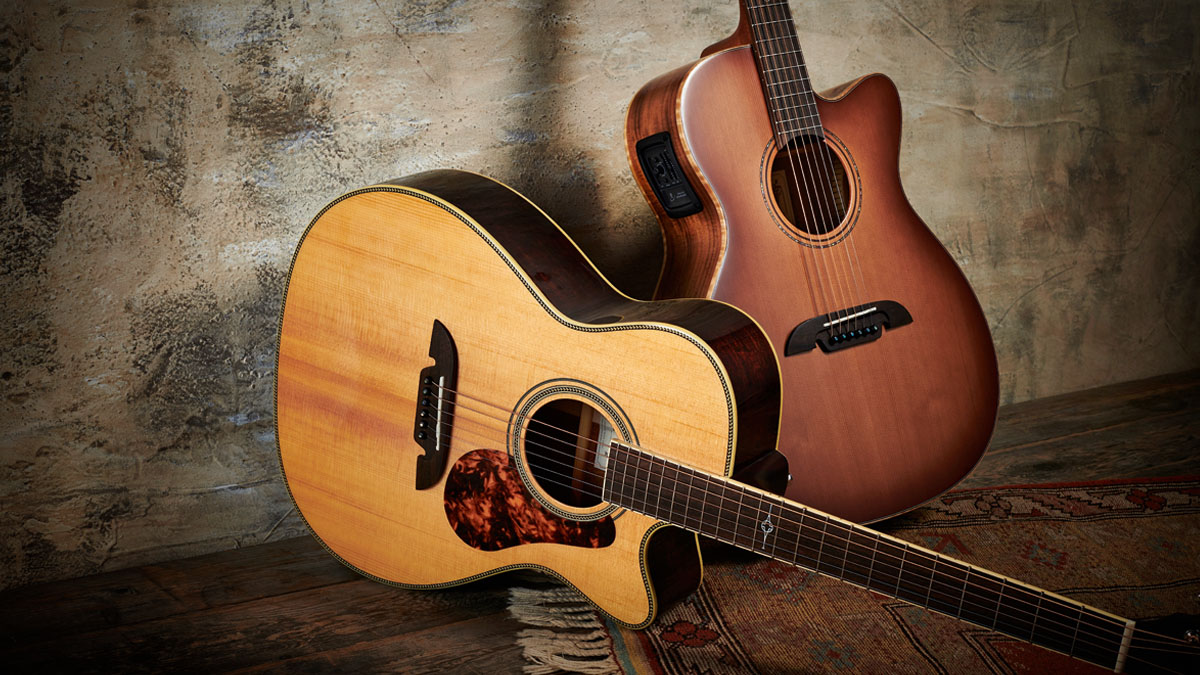Guitar World Verdict
With inventive solid-wood builds, excellent electronics and a vintage feel, Alvarez's new electro-acoustics are outrageously good value for money.
Pros
- +
Solid woods and stellar necks make for happy pluckers.
- +
Versatile tones, especially the Artist Elite model.
- +
The price tag.
Cons
- -
No lefties.
- -
No gigbag or case included.
You can trust Guitar World
It was only after a couple of its guitars landed on our doorstep that we realised how little we know about Alvarez. It’s one of those brands that feels like it’s been around forever. We all know the name. We’ve all heard good things. Before we get stuck into the review guitars, some due diligence.
Founded in 1965 by North American distributor St Louis Music, Alvarez was originally tasked with selling classical guitars. That explains the name. Then, as Chris Meikle, St Louis Music’s senior vice president of sales, marketing and product explains, that mandate changed sometime in the late 1960s…
“The company’s then owner, Mr Gene Kornblum, met Japanese master luthier Kazuo Yairi,” says Meikle. “They began developing steel-string acoustic guitars. The first Alvarez-Yairi instruments shipped to the US in 1970. Our premium Alvarez-Yairi models are still handmade in the Yairi factory in the small town of Kani in the hills north of Nagoya.”
- Best acoustic guitars: top strummers for beginners to pros
- Best acoustic guitars under $500: including acoustic electric guitars
Heads up, all you hungry wood worms out there. Tonight’s special is Sitka spruce served on a bed of African mahogany
The Masterworks MF60CEOM and Artist Elite AFA95CESHB guitars that just landed on our doorstep were constructed up the road in the People’s Republic of China. First impressions? Well, cases and gigbags might be conspicuous by their absence, but there’s no mistaking the quality of these models. Both guitars on review here are based around a classic OM body platform and feature cutaways and LR Baggs pickup gubbins. You’ll also get change out of 700 sheets.
Alvarez Masterworks MF60CEOM

According to Meikle, the Masterworks MF60CEOM has been designed to offer players “an all-solid wood guitar which is responsive and articulate, making it suitable for most musical styles”. All-solid woods?
Heads up, all you hungry wood worms out there. Tonight’s special is Sitka spruce served on a bed of African mahogany.
The aesthetic here is pre-war classic. The all-solid mahogany neck connects with the body at the 14th fret and comes chiselled with an old-school ‘V’ profile.
You’ll also find open gear tuners and herringbone binding on the top of the body. If we were talking about dry cleaning you could say this guitar has been ‘Martin-ised’. There’s a subtle clue for you.
Alvarez Artist Elite AFA95CESHB
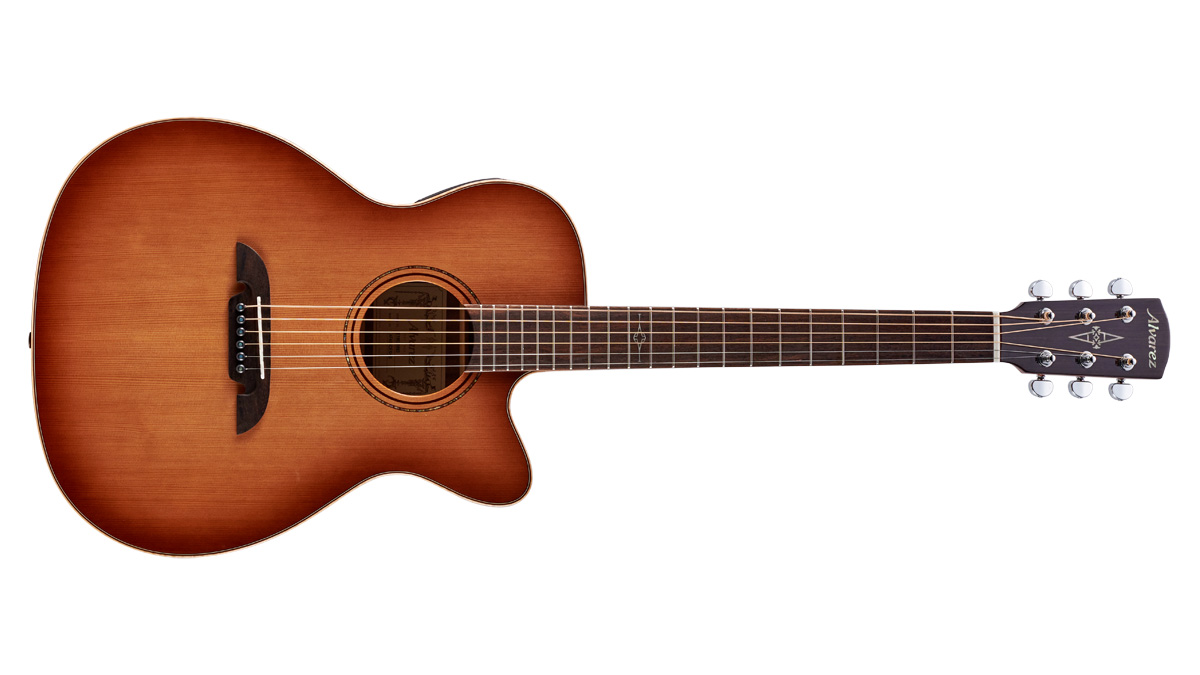
As for the Artist Elite, Meikle comments that “we had a very deliberate brief with those guitars. We wanted to make a small line of custom-style solid-top instruments from more exotic higher-grade timbers, with flawless finishes and features such as wood bindings. They offer a value that we believe is pretty hard to match.”
Here you get a solid western red cedar top and laminate acacia back and sides. It turns out acacia isn’t just the road that British comic strip superhero Bananaman lives on. As you no doubt already know, acacia, known commonly as mimosa, thorntree or wattle, is “a polyphyletic genus of shrubs and trees belonging to the subfamily Mimosoideae of the family Fabaceae”. We took the words right out of your mouth there, huh?
To understand this eye-catching timber, there are apparently over 1,000 species of acacia. Koa, the wood used in acoustic guitar manufacture, is an acacia. Koa sounds like a denser version of mahogany. Therefore it shouldn’t be too much of a stretch to expect our acacia-fuelled Artist Elite to exhibit the same tendencies. We’ll keep you posted.
What of the western red cedar? Well, a brand-new solid Sitka spruce top is like a virginal choirboy, all crystalline highs with nowt going on in the balls department. Cedar already has a bumfluff ’tache, hanging round Tesco’s hassling old guys to buy it a bottle of cider. In other words, you have to put some work into developing the voice of a spruce top. You get a head start with cedar.

The MF60CEOM’s bi-level bridge is designed to increase string tension for more sustain. That battle against note decay is helped with a real bone saddle and top nut. The Artist Elite guitar offers exactly the same setup.
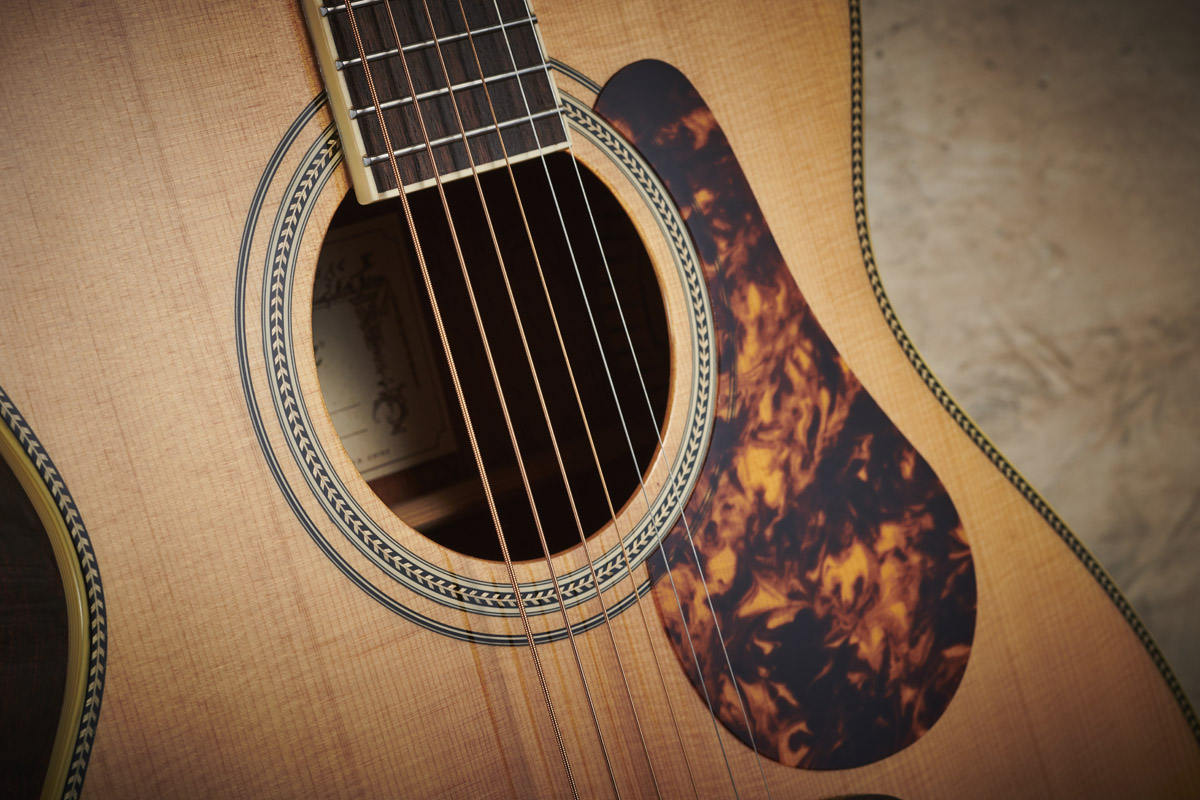
The Masterworks’ solid Sitka spruce top and African mahogany back and sides will accommodate strumming, but excels with finger-picking, with a punchy, responsive midrange to its tone.
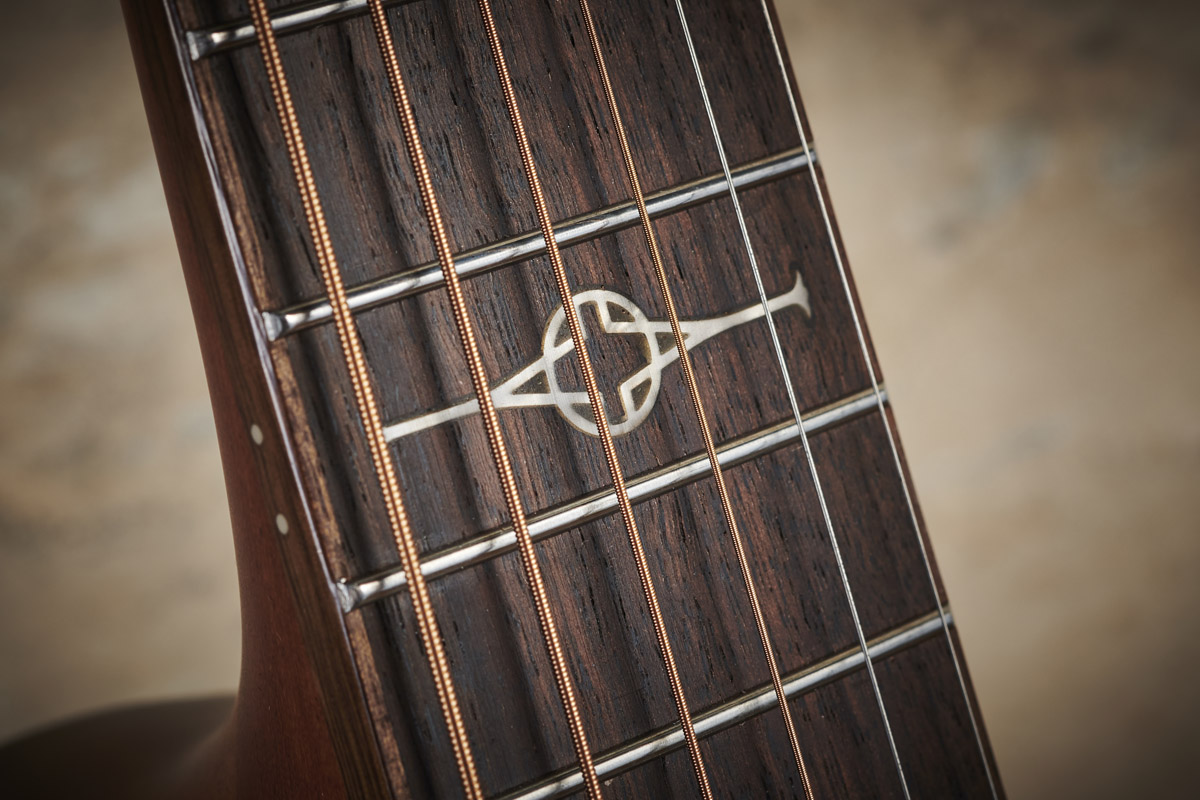
Our review guitars feature either a pau ferro or Indian Laurel fingerboard, depending on what’s in stock during production. Both timbers are popular stand-ins for rosewood, which came under protection. If we hadn’t told you, there’s a real possibility you’d never guess this wood isn’t rosewood.
Feel & sounds
While the MF60CEOM’s slim V-shaped neck profile greets us like an old pal, the Artist Elite AFA95CESHB is packing something even more compelling. Here you’ll find a subtle ‘V’ at the top nut and it gradually transforms into a C shape as you pass by the 5th fret.
Says Meikle: “We think it feels more comfortable as you position your hand differently toward the nut than you do if you’re in the middle of the neck.”
As we’ve already said, both of these guitars are influenced by the Martin OM body style. There is a subtle difference. A Martin OM has a 645mm (25.4-inch) scale length. Our Alvarez guitars are spec’d with a 630mm (24.8-inch) scale.
That shortfall in scale adds a little warmth to the expected bright and articulate response of the Masterworks’ solid Sitka spruce top and African mahogany back and sides. It’ll accommodate your strumming requirements, but really comes to life when you brush the strings with fingertips.
While the bottom-end is in the post, there is a piano-like sustain in there, not to mention a punchiness to the midrange that reacts well to the dynamics of your picking.
Hit the cedar-topped Artist Elite hard and you get a bit more Ray Winstone than Aled Jones. In classic cedar style, it feels like this guitar has some life experience compared with the newborn Masterworks.
That laminate acacia blasts notes out of the soundhole like there’s a little Babe Ruth in there, smacking them out with a baseball bat. This guitar has the Alvarez MST1 internal structure in its slightly wider body.
You get tapered X bracing and asymmetric tone bars. Long story short, the intention is a vibrant open tone. Mission accomplished. Both guitars feature bona fide skeletal top nuts and saddles. Their bi-level bridges are designed to increase string tension for more sustain. The shorter scale length you’ll encounter means that you never feel like you’re fighting these guitars.
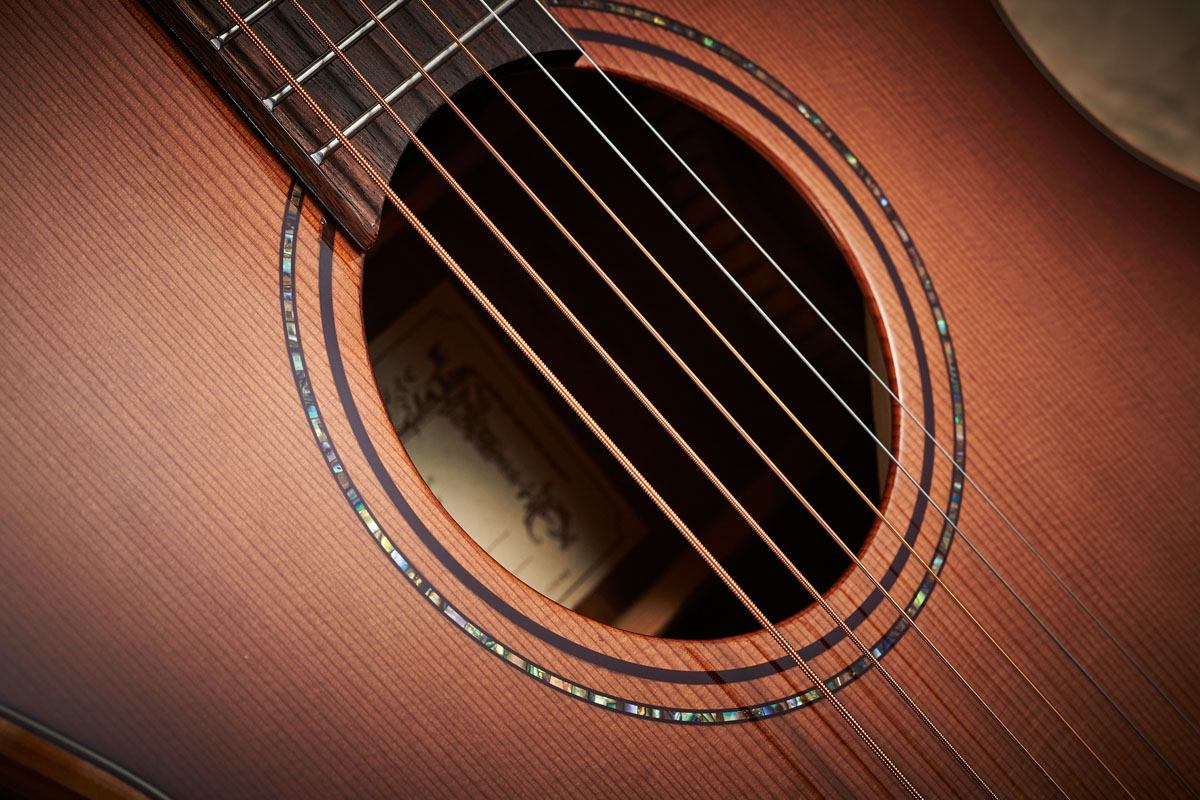
These guitars feature LR Baggs’ excellent Element under-saddle pickup. Unlike existing units, this pickup reduces that annoying quack you get when you hit the strings hard. While the Masterworks features volume and tone controls, the Artist Elite offers a three-band EQ and tuner.
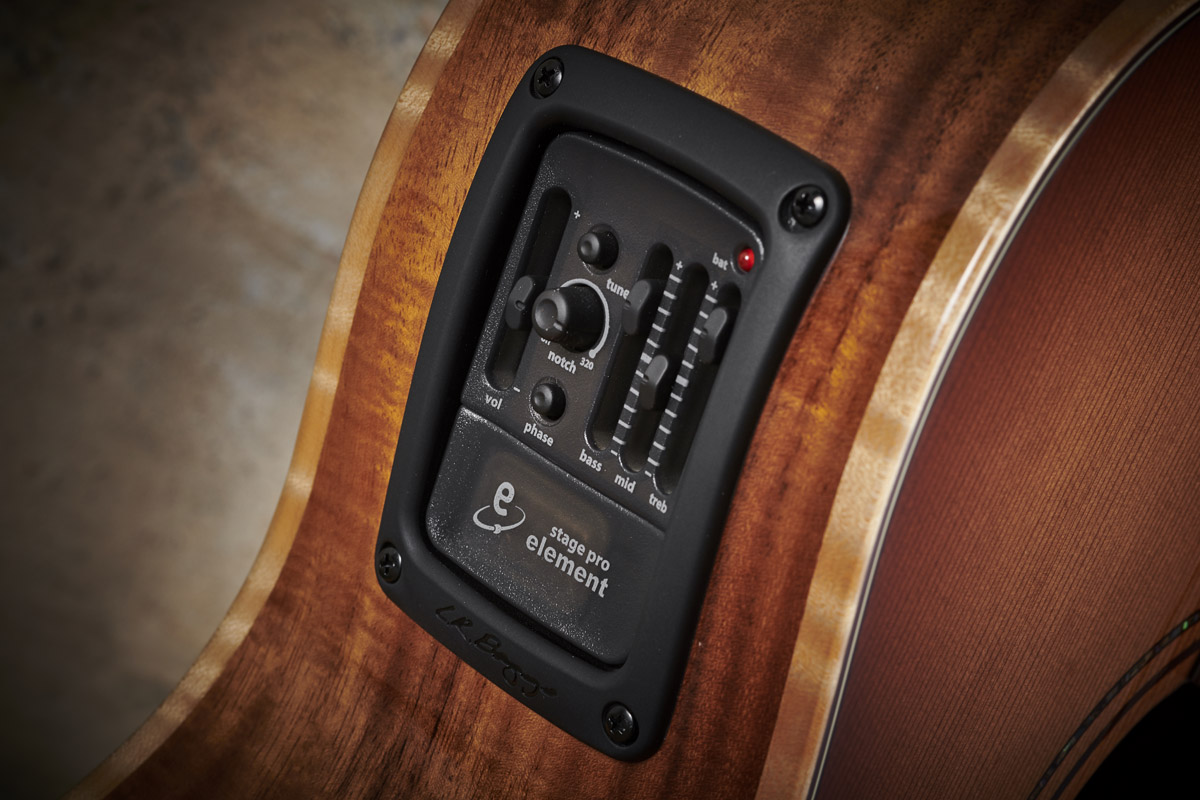
The Artist series has an LR Baggs Element under-saddle pickup and a three-band Stage Pro EQ for dialling in your tone. It also has a phase button, tuner and notch filter control to kill feedback.
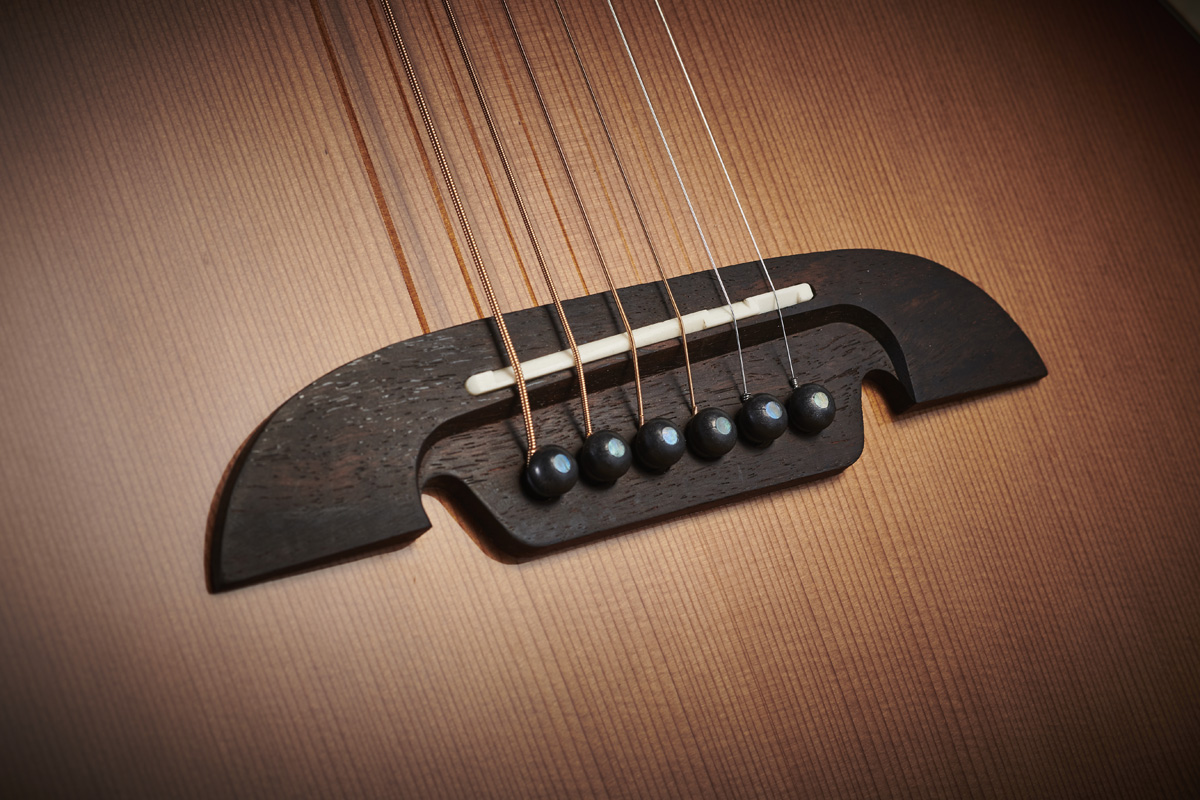
Like the Masterworks model, the Artist Series has a bi-level bridge to increase string tension.
When it comes to the onboard LR Baggs pickup systems, we prefer the Element under-saddle pickup that’s common to both guitars. This thing feeds off the movement of the soundboard not the compression of the strings. The result is an authentic acoustic tone minus that annoying quack you get with many other more traditional under-saddle units.
While the Masterworks offers discreet soundhole-mounted volume and tone controls, the Artist Elite has a more conventional preamp with external controls. You get to finger a three-band EQ (bass, mid, treble, natch). There’s also a phase button and a notch filter knob to help hunt down and kill feedback. The easy-to-read tuner is a nice bonus.
Verdict
“Your two review guitars are a great example of what we can deliver in terms of value and quality,” Chris Meikle tells us. “We have dedicated ourselves to be the best at every price point we make a guitar in and I think we’re getting hard to beat.”
He would say that. He’s one of the boys over at SLM. We, on the other hand, don’t have a dog in this fight. The fact is, though, everything Mr Meikle says is backed up by the performance of this pair.
To us, the MF60CEOM feels like the family heirloom guitar. Strumming and picking this guitar as it reaches its full potential will be a pleasure. The AFA95CESHB is the guitar you lug around for gigs, rehearsal rooms and studios. It feels even more robust than the Masterworks guitar. We love the neck profile, too. The V-to-C thing is the business.
While it was good to peer into the history of Alvarez, we’re all about the now. We’re impressed. Okay, they don’t come with a case or gigbag; just suck it up. These guitars are a bargain. As Chris Meikle puts it: “You get a hell of a lot of guitar for your money. That’s what we do.” Yeah, what he said
Specs
Alvarez Masterworks MF60CEOM
- PRICE: $699.99 / £699
- ORIGIN: China
- TYPE: Folk/OM-size electro-acoustic with cutaway
- TOP: Solid AA Sitka spruce with herringbone binding
- BACK/SIDES: Solid African mahogany
- MAX RIM DEPTH: 106mm
- MAX BODY WIDTH: 390mm
- NECK: 1-piece mahogany with 50/50 semi-gloss finish
- SCALE LENGTH: 630mm (24.8”)
- TUNERS: Nickel open gear
- NUT/WIDTH: Bone/44.45mm
- FINGERBOARD: Pau ferro or Indian Laurel with Paua abalone and mother-of-pearl inlays, 406mm (16”) radius
- FRETS: 22, vintage
- BRIDGE/SPACING: Bi-level pau ferro or Indian Laurel/54mm
- WEIGHT (kg/Ib): 1.85/4.1
- PICKUP/PREAMP: LR Baggs VTC Element System
- RANGE OPTIONS: Masterworks MF600M all-acoustic solid Sitka spruce top and solid African mahogany back and sides; left-handed Masterworks MPA66SHBL Parlour, all-solid African mahogany construction
- LEFT-HANDERS: No
- FINISH: Natural Gloss (as reviewed)
Alvarez Artist Elite AFA95CESHB
- PRICE: $599.99 / £659
- ORIGIN: China
- TYPE: Folk/OM-size electro-acoustic with cutaway
- TOP: Solid AA western red cedar
- BACK/SIDES: AAA acacia (laminate)
- MAX RIM DEPTH: 106mm
- MAX BODY WIDTH: 385mm
- NECK: Mahogany with 50/50 semi-gloss finish
- SCALE LENGTH: 630mm (24.8”)
- TUNERS: Chrome die-cast
- NUT/WIDTH: Bone/44.45mm
- FINGERBOARD: Pau ferro or Indian Laurel with Paua abalone and mother-of-pearl inlays, 406mm (16”) radius
- FRETS: 21, vintage
- BRIDGE/SPACING: Bi-level pau ferro or Indian Laurel/54mm
- WEIGHT (kg/Ib): 2.3/5.2
- PICKUP/PREAMP: LR Baggs Element with StagePro EQ
- RANGE OPTIONS: Other Artists Elite models include dreadnought and grand auditorium sizes
- LEFT-HANDERS: No
- FINISH: Shadowburst (as reviewed)
- CONTACT: AlvarezGuitars.com
Ed Mitchell was Reviews Editor on Total Guitar magazine from 2003, and his guitar-modding column, Ed’s Shed, appeared in print on both sides of the Atlantic (in both Total Guitar and Guitar World magazines). He was the Editor of The Blues Magazine from 2012-16, and a contributor to Guitarist, Classic Rock and Louder. He died in October 2022, aged 52. Between them, the websites Guitar World, Louder and MusicRadar host over 400 of his articles – among them interviews with Billy Gibbons, Paul Weller, Brian Setzer, profiles on Roy Buchanan, Duane Allman and Peter Green, a joint interview with Jimmy Page and Jack White, and dozens of guitar reviews – and that’s just the ones that made it online.
“While the odd corner has clearly been cut, these are true Gibsons with all the individuality that this brand exhibits”: Gibson J-45 Special and Hummingbird Special review
“Fender has stripped back the price – but has it gone too far paring back the sounds, too?” Fender Standard Acoustasonic Telecaster review
